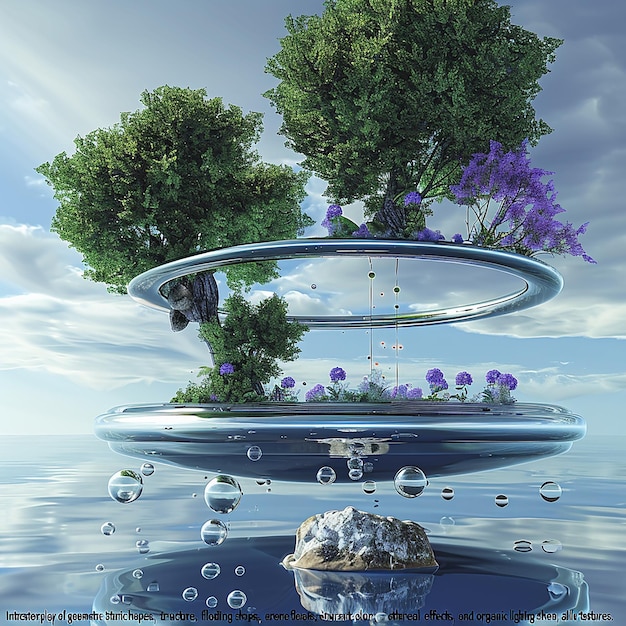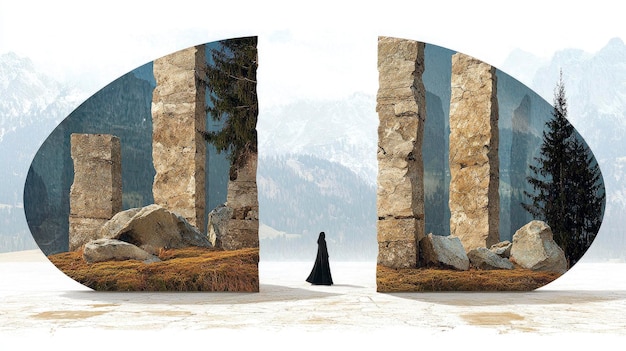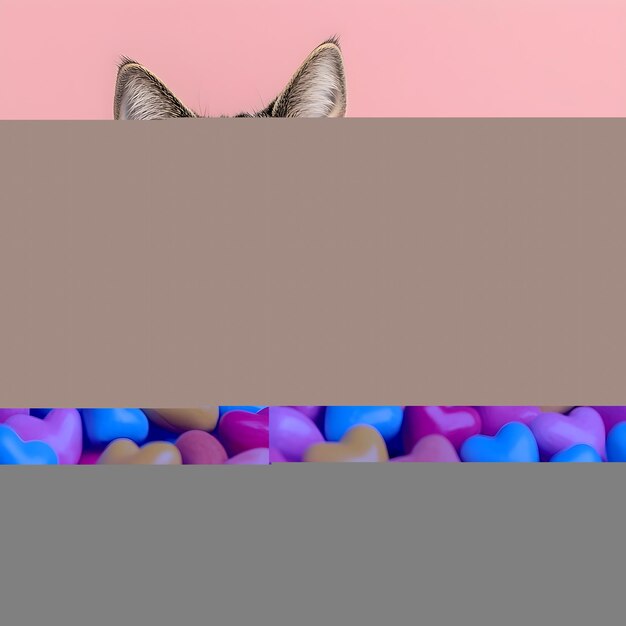AI-Generated Art: Creating Viral Images in 2025

AI-Generated Art is rapidly evolving, offering new avenues for creating viral images in 2025 through user-friendly platforms, innovative techniques, and strategic content creation that leverages AI’s capabilities to produce engaging and shareable visual content.
The world of art is changing, and AI-Generated Art is leading the revolution. Imagine creating images that capture the internet’s attention, all powered by artificial intelligence. It’s not science fiction; it’s happening now.
Understanding the Rise of AI-Generated Art
AI-generated art is no longer a niche curiosity but rather a mainstream phenomenon. With advancements in machine learning and accessible tools, creating stunning visuals is now within reach for anyone.
What is AI-Generated Art?
AI-generated art refers to images, videos, and other visual content created using artificial intelligence algorithms. These algorithms analyze vast datasets of existing art to learn styles, patterns, and techniques, and then generate new, original pieces based on that knowledge.
Key Technologies Driving the Trend
- Generative Adversarial Networks (GANs): GANs consist of two neural networks, a generator that creates images and a discriminator that evaluates them. These networks compete to refine the generated output until it meets a high standard of realism and artistic quality.
- Diffusion Models: Diffusion models work by adding noise to an image and then learning to reverse the process, gradually removing the noise to reveal a coherent image. This method often produces incredibly detailed and realistic results.
- Text-to-Image Models: These models, like DALL-E 2 and Midjourney, can generate images from textual descriptions, allowing users to create visuals simply by typing what they want to see.
The confluence of these technologies has democratized art creation, enabling both artists and non-artists to bring their visions to life effortlessly.
AI-generated art has transformed from a novelty to a powerful tool for creative expression, fueled by advancements in GANs, diffusion models, and text-to-image technologies.

Choosing the Right AI Art Generator
Selecting the best AI art generator can significantly impact the quality and style of your creations. Several platforms offer unique features and cater to different skill levels.
Top AI Art Platforms in 2025
- Midjourney: Known for its artistic and dreamlike outputs, Midjourney is accessible through Discord. It’s particularly favored for abstract and surreal art.
- DALL-E 2: Developed by OpenAI, DALL-E 2 excels at creating photorealistic images from textual prompts. It’s a versatile tool for various artistic styles and concepts.
- Stable Diffusion: An open-source option, Stable Diffusion allows users to run AI art generation locally, providing greater control and customization.
- Jasper Art: Integrated within the Jasper AI writing platform, Jasper Art is designed for marketers and content creators needing quick, high-quality visuals.
Factors to Consider When Choosing
- Ease of Use: Consider your familiarity with AI tools. Some platforms offer simpler interfaces, while others require more technical knowledge.
- Artistic Style: Different platforms excel at different styles. Experiment to find one that aligns with your creative vision.
- Cost: Many AI art generators operate on subscription models. Evaluate the pricing and features to find the best value.
Choosing the right AI art generator involves balancing ease of use, artistic style, and cost to align with your individual needs and preferences.
Crafting Effective Prompts for Stunning Results
The quality of your AI-generated art hinges on the prompts you provide. Clear, detailed prompts guide the AI in creating images that match your vision.
Understanding Prompt Engineering
Prompt engineering involves crafting textual descriptions that effectively communicate your artistic intent to the AI. It’s about finding the right balance between specificity and creativity.
Tips for Writing Great Prompts
- Be Specific: Include details about the subject, style, colors, and composition.
- Use Keywords: Incorporate relevant keywords that align with the artistic style you desire.
- Experiment: Try different prompts and variations to see how the AI interprets them.
Example Prompts:
* “A cyberpunk cityscape at dusk, neon lights, high-resolution, detailed.”
* “An oil painting of a serene forest, impressionistic style, soft lighting.”
* “A futuristic robot meditating in a zen garden, digital art, vibrant colors.”
Mastering prompt engineering through specificity, relevant keywords, and experimentation allows you to guide AI art generators to produce stunning, tailored results.
AI art generation isn’t about simply typing a word and hitting ‘generate’. It’s an art in itself, a collaboration between human imagination and artificial intelligence.

Optimizing Your AI Art for Virality
Creating viral images involves more than just generating stunning art. Strategic optimization and promotion are essential for capturing the internet’s attention.
Understanding Viral Content
Viral content resonates with a broad audience, often evoking strong emotions, sparking curiosity, or offering unique value. Identifying these elements can help tailor your AI art for maximum impact.
Strategies for Going Viral
- Leverage Trends: Incorporate current internet trends and memes into your AI art to increase its relevance and shareability.
- Evoke Emotion: Create images that elicit strong feelings, whether it’s humor, awe, nostalgia, or inspiration.
- Tell a Story: Use AI art to visually narrate compelling stories that captivate and engage viewers.
Viral content often stems from a combination of capturing current trends, evoking strong emotions, and telling compelling stories through visually striking AI-generated art.
Leveraging Social Media Platforms
Social media is the primary battleground for gaining visibility and achieving virality. Understanding each platform’s unique audience and content preferences allows you to tailor your approach effectively.
Best Platforms for Sharing AI Art
- Instagram: Ideal for visually appealing content, Instagram is perfect for showcasing high-quality AI art. Use relevant hashtags to increase visibility.
- TikTok: Known for viral trends and short-form videos, TikTok offers opportunities to create engaging AI art animations and time-lapses.
- Twitter: Perfect for sharing thought-provoking AI art with accompanying commentary. Engage in relevant conversations to expand your reach.
- Pinterest: A visual discovery platform, Pinterest is great for sharing AI art that inspires and provides value. Optimize images with relevant keywords for better searchability.
Engaging with Your Audience
Engaging with your audience through comments, questions, and polls can build a community around your AI art. Responding to feedback and fostering interaction increases engagement and inspires more shares.
Social media platforms provide an ideal stage for showcasing AI art, demanding tailored strategies, engagement techniques, and platform-specific content production.
Monetizing Your AI Art Creations
Turning your AI art into a revenue stream is increasingly viable, with various avenues for monetization.
Exploring Monetization Options
- Selling Prints and Merchandise: Platforms like Etsy and Redbubble allow you to sell prints, posters, and merchandise featuring your AI art.
- NFTs (Non-Fungible Tokens): Minting your AI art as NFTs can create unique digital assets that collectors are willing to purchase.
- Licensing Your Art: License your AI art to businesses and organizations for use in marketing materials, websites, and other projects.
Monetizing your AI art can involve selling prints, minting NFTs, or licensing your art for commercial use, each offering unique income opportunities.
The increasing popularity of AI-generated art presents an exciting time for creators to tap into emerging markets and generate income from their digital masterpieces.
| Key Point | Brief Description |
|---|---|
| 🎨 AI Art Platforms | Midjourney, DALL-E 2, and Stable Diffusion are top choices. |
| ✍️ Prompt Engineering | Craft specific and detailed text prompts for desired AI art. |
| 🚀 Viral Strategies | Leverage trends, evoke emotion, and tell stories for virality. |
| 💰 Monetization | Sell prints, NFTs, or license art commercially. |
FAQ: AI-Generated Art
▼
DALL-E 2 is often recommended for beginners due to its user-friendly interface and ability to generate high-quality images from simple textual prompts. Its intuitive design makes it easy to experiment and learn.
▼
Improving the quality involves crafting more detailed and specific prompts. Include keywords that define the style, subject, and composition you want. Experimenting with different prompts is crucial.
▼
The definition of “real art” is subjective and evolving. AI art is recognized as a form of creative expression, though debates continue about the role of the artist versus the algorithm in its creation.
▼
Legal aspects such as copyright are complex and vary by jurisdiction. Generally, if you create AI art using your own prompts and inputs, you often hold the rights, but it is crucial to review terms of service.
▼
Yes, you can use AI art for commercial purposes, such as selling prints, merchandise, or licensing it. However, it’s essential to ensure you have the necessary rights and comply with the terms of service of the AI platform.
Conclusion
AI-Generated Art is transforming the creative landscape, offering endless possibilities for viral images and monetization. By selecting the right tools, mastering prompt engineering, and optimizing for social media, anyone can harness the power of AI to create captivating content that resonates with audiences worldwide.
